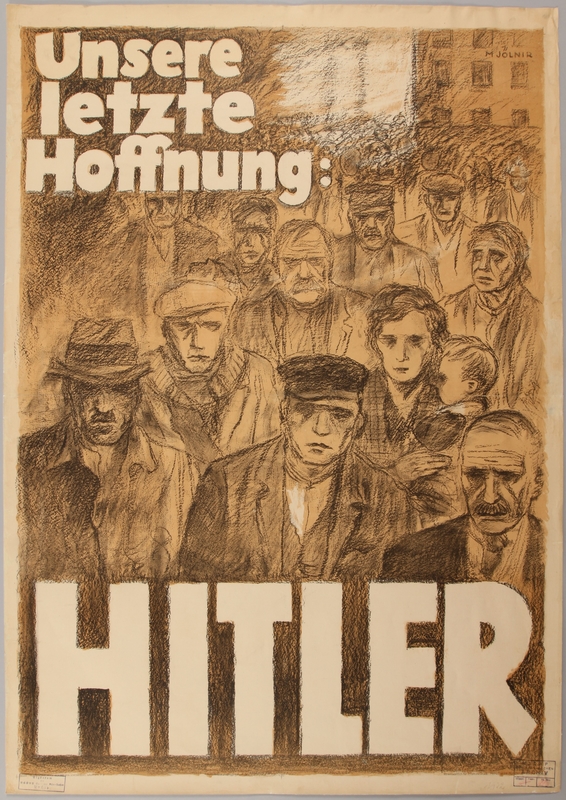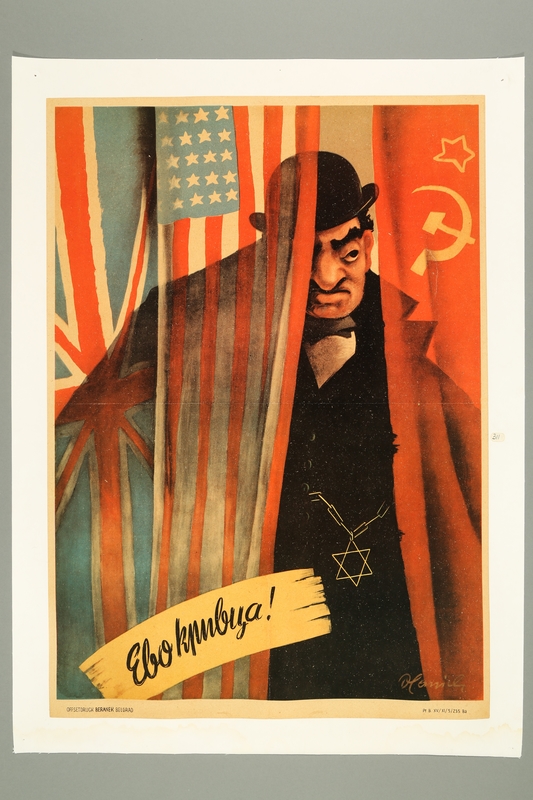28 Nazi Germany by Aaron Redmond
1. Nazi Germany: Analysing and evaluating propaganda

Reichsparteitag-Nurnberg 1936, Ludwig Hohlwein, Wikimedia Commons, CC BY-SA 4.0
| Curriculum context | VCE Unit 1: Modern History, Area of Study 2 (VCAA, 2020)
|
| Historical context | World War II > The Holocaust > Nazi Propaganda |
| Historical thinking concept |
Use sources as evidence |
| Learning intentions
|
Understanding the use of propaganda to influence, change and control political and social agendas.
Understanding the process of analysing primary sources by identifying helpful information and interpreting and evaluating its intended audience, message and effectiveness. Engage in collaborative work and discussion. |
Activity
You will be analysing propaganda produced by the Nazi Party to understand how the Nazis used it to influence, change and control political and social agendas. In groups, you will participate in a collaborative gallery walk where you will be using the image analyse process to analyse and evaluate Nazi propaganda (Facing History and Ourselves, 2008, 2009, 2022) . The class will then come together to discuss what information has been gathered with each group briefing the class about their analysis and evaluation on one of the images.
Collaborative gallery walk and image analysis
In groups of four, you will be moving around the classroom, exploring a multitude of different Nazi Propaganda images (see below) to analyse and evaluate. To make sure each group has an ample amount of time to analyse and evaluate the images, your group will have five minutes to collect information from one image before moving to the next one in the gallery. Some basic information will be placed under the image to provide a base for your analysis such as its title and translation of the text. Use the image analysis handout to guide your analysis and evaluation of the sources:
Step One: Description
This step involves describing what information you see, such as the colours, lines and placement of objects.
Step Two: Identification
This step involves recording basic information about the source. This includes finding out:
- Who created it?
- When was it created?
- If it involves text, what does it say?
Step Three: Interpretation
This step involves analysing the source’s message based on what you know about the source:
- What message do you think the author wanted to express?
- Who is the intended audience for this image?
- What do you think about this message would be appealing to this audience?
- What do you think the author wanted the audience to think, feel and do once they saw the image?
Step 4: Evaluation
This step involves determining the source’s effectiveness:
- Does the image successfully communicate its intended message?
- Does the image use misinformation to express its message?
- Does the image express a positive or negative message?
Collaborative gallery walk images
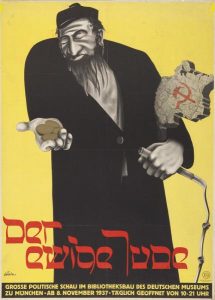
Image 1: The Eternal Jew 1937, Horst Schluter, Wikimedia Commons, Public Domain
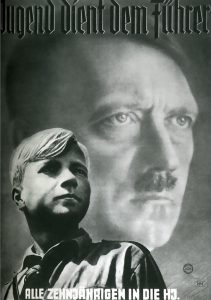
Image 2: WWII Propaganda – Nazi Germany, Author Unknown, Openverse, CC BY-NC-SA 2.0

Image 3: Long Live Germany 1933, K Stauber, Wikimedia Commons, CC BY-SA 4.0
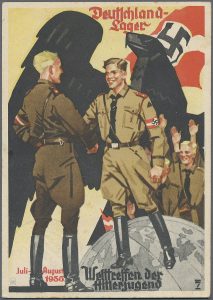
Image 4: World Meeting of Hitler Youth 1935, Ludwig Hohlwein, Wikimedia Commons, CC BY-SA 4.0
Image 5: ‘Our Last Hope – Hitler’ 1932, Hans Schweitzer, United States Holocaust Memorial Museum, Public Domain
Image 6: ‘Here’s the Culprit!’ 1941, Hamil, United States Holocaust Memorial Museum, Public Domain
Part 3: Group presentation and discussion
As a group, share your answers from the image analysis process handouts about one of the Nazi propaganda images from the gallery walk to the rest of the class. Write down any information presented by the other groups that you might have missed about the other images.
References
Facing History & Ourselves. (2008, February 24). Analyzing Images. https://www.facinghistory.org/resource-library/analyzing-images
Facing History & Ourselves. (2022, November 1). Image Analysis Procedure. https://www.facinghistory.org/resource-library/image-analysis-procedure
Facing History & Ourselves. (2009, September 23). Gallery Walk. https://www.facinghistory.org/resource-library/gallery-walk-0
VCAA. (2020). VCE Study Design: History 2022-2026. Victorian Curriculum and Assessment Authority.. https://www.vcaa.vic.edu.au/curriculum/vce/vce-study-designs/history/Pages/index.aspx
2. Nazi Germany’s Jewish ghettos: Exploring historical perspectives
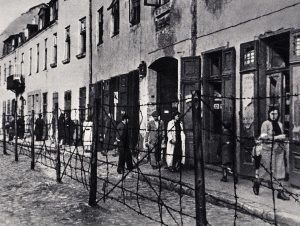
Krochmalna Street Warsaw Ghetto, Stanislaw Poznanski, Wikimedia Commons, Public Domain
| Curriculum context |
VCE Unit 1: Modern History, Area of Study 2 (VCAA, 2020)
|
| Historical context |
World War II > The Holocaust > Jewish perspectives and experiences
|
| Historical thinking concept | Explore historical perspectives |
| Learning intentions
|
Identify how exclusion and the political, social and cultural conditions changed everyday life through the exploration of Jewish historical perspectives and experiences. Develop historical empathy through understanding an historical event from the perspective of those who experienced it first-hand. Engage in collaborative work and discussion. |
Activity
You will be exploring the concept of historical perspectives and how engaging with them provides valuable insight into past events. You will be examining the perspectives of the Jewish people who were forced by the Nazi’s to live in ghettos during World War II. You will be assigned a particular point of view character/historical actor and will be tasked with researching what their perspective and experiences might have been inside the ghetto. You will then participate in a collaborative café conversation (Facing History and Ourselves, 2009) where you will be using the information you have researched in a conversation about life in the ghetto with the members of your group who are each representing a different point of view character. After this, the class will come together to discuss the conversations and what information has been learned.
Part 1: Researching Sources and Historical Perspectives.
You will be randomly assigned one of six point of views to represent. These include:
- A member of the Jewish Council
- A member of the Jewish Police
- A member of the Jewish underground resistance
- A parent with children
- A forced labourer working in one of the Nazi’s factories
- A Rabbi
Working individually, you will research online, using your assigned character as a guide to find the relevant background information you’ll need to know about their perspective of life inside the ghetto. As part of your exploration, you could use the following resources to guide your research:
- Jewish Uprisings in Ghettos and Camps, 1941-44 | United States Holocaust Memorial Museum
- Labor in the Lodz Ghetto | Yad Vashem
- Ghetto Police | YIVO Encyclopedia of Jews in Eastern Europe
- Family During the Holocaust | Jewish Women’s Archive
- Judenräte (Jewish Councils) | Britannica
- “On Religious Life” | USHMM
Part 2: Collaborative café conversation
You will then be placed into groups of six, participating in a café conversation with each group member representing a different point of view character. A member of your group will initiate the conversation with a question or statement about something which has transpired within the ghetto, such as ‘did you see ___ happened, what do you think about it?’. Make sure you record what you have been able to learn about the other point of view characters in your conversation.
It’s important to note that you are not in 2023 representing yourself, you are in 1941, representing a Jewish individual living inside one of the Jewish ghettos during World War II.
This task aims to help you develop your historical consciousness and historical empathy skills. You are being challenged to look beyond your personal biases, feelings and experiences when engaging with these historical perspectives, while also acknowledging that you are empathising and using your historical imagination that is shaped by your own worldviews and experiences in the present.
Part 3: Class discussion and reflection
The class will then come together to discuss and reflect on the café conversation activity, with each group sharing what it was like to take part in the café conversation, what you were able to learn about the other point of view characters and what you were ultimately able to learn about Jewish ghettos and your insight into the perspectives and experiences of the Jewish people who lived within them.
References
Ben-Sasson, H. (2010, August 9). Ghettos: Ghetto Police. YIVO Encyclopedia of Jews in Eastern Europe. https://yivoencyclopedia.org/article.aspx/Ghettos/Ghetto_Police
Berenbaum, M. (2011, June 30). Judenräte. Encyclopedia Britannica. https://www.britannica.com/topic/Judenrate
Facing History & Ourselves. (2009, November 12). Café Conversations. https://www.facinghistory.org/resource-library/cafe-conversations
Ofer, D. (2021, July 14). Family During the Holocaust. https://jwa.org/encyclopedia/article/family-during-holocaust
United States Holocaust Memorial Museum. (n.d.). Jewish Uprisings in Ghettos and Camps, 1941-44. https://encyclopedia.ushmm.org/content/en/article/jewish-uprisings-in-ghettos-and-camps-1941-44#resistance-in-ghettos-0
United States Holocaust Memorial Museum. (n.d.). Rabbi Shimon Huberband, “On Religious Life”. https://perspectives.ushmm.org/item/rabbi-shimon-huberband-on-religious-life
VCAA. (2020). VCE Study Design: History 2022-2026. Victorian Curriculum and Assessment Authority. https://www.vcaa.vic.edu.au/curriculum/vce/vce-study-designs/history/Pages/index.aspx
Yad Vashem. (n.d.). Labor in the Clothes Workshop, Lodz Ghetto, Poland, February 1941. https://www.yadvashem.org/holocaust/this-month/february/1941-2.html

